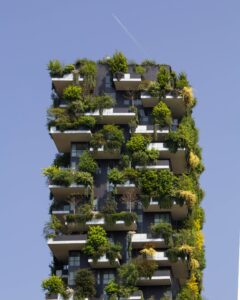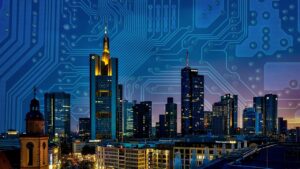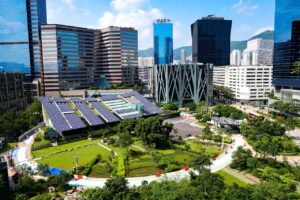Sustainable city: principles, challenges and technological implications
Creating sustainable cities has become essential in a world that is rapidly urbanizing. Let's discover these new digital technologies.

Urbanization is an international concern. Cities are currently home to more than half of the world's population. By 2050, seven out of ten people will be city dwellers. Yet cities are responsible for 70% of carbon emissions and consume 60 to 80% of the energy produced. This widespread urbanization presents many challenges, particularly in terms of the environment, health and the economy. Hence the interest in setting up sustainable cities. But what does this concept really mean? What does it imply in terms of technology?
Definition of a sustainable city
From a conceptual point of view, the sustainable city is one of the many territorial implementations of sustainable development. Practically, a sustainable city is based on ecological urban planning and the city's ability to satisfy the population's basic needs locally.
In other words, a city is referred to as sustainable when the city's inhabitants and economic activities continuously improve the natural environment, architecture and regional culture. The implementation of a sustainable city is applied in different areas: energy consumption, mobility and transport networks, waste management, as well as buildings.
The sustainable city involves various issues and challenges:
- improving the quality of life of the urban population;
- optimizing mobility;
- supplying high performance equipment;
- the competitiveness of the city;
- the efficiency of urban services and management;
- the preservation of a pleasant living environment.
Moreover, the notion of sustainability implies respecting the needs of both current and future generations, both economically and socially, as well as environmentally and culturally.
The sustainable city is a greener city
To conform with this sustainability perspective, cities must be increasingly green. Besides, the use of renewable energy sources is a prerequisite for a sustainable city: solar energy, geothermal energy, biomass and hydrogen. It is indeed an energy transition that is closely linked to the evolution of technology.
A green city is also a city that places great importance on vegetation and trees. The creation of green corridors, the preservation of urban forests, or the installation of green walls and roofs are therefore essential. Moreover, this greenery helps to reduce heat islands and regulate temperatures within cities. It also helps preserve natural resources and the ecological balance.
Sustainable city and smart city
Many researchers and specialists agree that it is not possible to talk about sustainable cities without considering the notion of smart cities . Indeed, the smart city is a connected city that relies heavily on various technologies to improve the living environment of the population. Let's dive into some of them.
Technology at the service of the sustainable city
Artificial intelligence (AI), the spearhead of the smart city, makes it possible to analyze large volumes of data to help the decision-making process of city officials. For example, it can help to better manage the urban transport network.
Digital twins use virtual and augmented reality. They facilitate city planning and predicting the consequences of change by testing hypothetical projects.
Objects are being supplemented by computing devices with sensors and software that connect to each other. This is the Internet of Things. Information is collected in real time via wireless communication systems. This is the case, for example, with leak detection devices in pipes, garbage cans that optimize the passage of waste collection trucks, etc.
Robots and aircrafts are also used in many fields such as construction, transportation, surveillance and healthcare.
Energy management in a sustainable city
Sustainability is also a matter of smart power grids. They use digital communication technologies to detect and react to fluctuations. Such power grids help to optimize urban energy consumption. In fact, sensors and smart meters with Internet Protocol-based addresses are able to communicate energy consumption information to energy suppliers.
Thanks to its sensors that collect and transfer data from homes and urban businesses, it is possible to control and adjust the energy supply. This ultimately helps to reduce the carbon footprint of cities.
In addition, it should also be noted that smart distribution networks allow the control of water availability and potability.
As you can see, technology and sustainable cities are interdependent. Digital technologies greatly facilitate the implementation of smart devices that make cities more sustainable and environmentally friendly. Nevertheless, in order to improve the quality of urban life, the users of smart and sustainable cities must also take action and gradually appropriate the innovations implemented.




